Why "Young Technician" will not be able to build a laser
Greetings to everyone again. In the comments to my first article about a homemade laser machine, we again recalled an article from the magazine “Young Technician”, which was called “Building a laser”. It proposed a step-by-step description of the assembly of a pulsed laser operating on a liquid solution of an organic dye. The text of the article is available after 2 minutes of googling.
Despite this, neither I nor my colleagues know any precedents for the successful construction of a dye laser based on this article. Why is that? What are the hidden pitfalls in dye lasers? What is the structure of industrial dye lasers? Let's see.

Dye laser is very attractive for self-production. Since it does not need scarce and hard-to-reach crystals or glasses, or complex glassblowing work as for the manufacture of active elements of gas lasers. It consumes very little energy and produces a bright radiation of the visible range. Its radiation has a very valuable property - it can be decomposed into a spectrum and select the desired color of the beam.
')
To begin with, it should be noted that the article from “YT” No. 8 of 1971, which was later reissued in No. 11 of 1992, is not original. This is an adaptation of an article published in the column “The amateur scientist” of the American journal “Scientific American” in the February 1970 issue. And everything would be fine (maybe!) If this adaptation had not been performed with unacceptable cuts and annoying errors. First, look at the volume of both articles. The original article took 6 pages, adapted in “UT” - only 3 pages. Pictures copied almost 1 in 1. The original American article can be downloaded from here, having stolen it from the angry copywriters through sci-hub. Or already from file sharing .
Compare the similarity of pictures in the original and adapted articles.
Original:
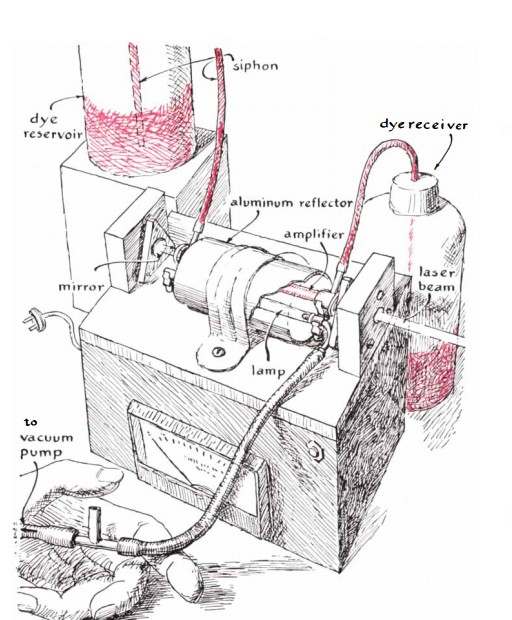
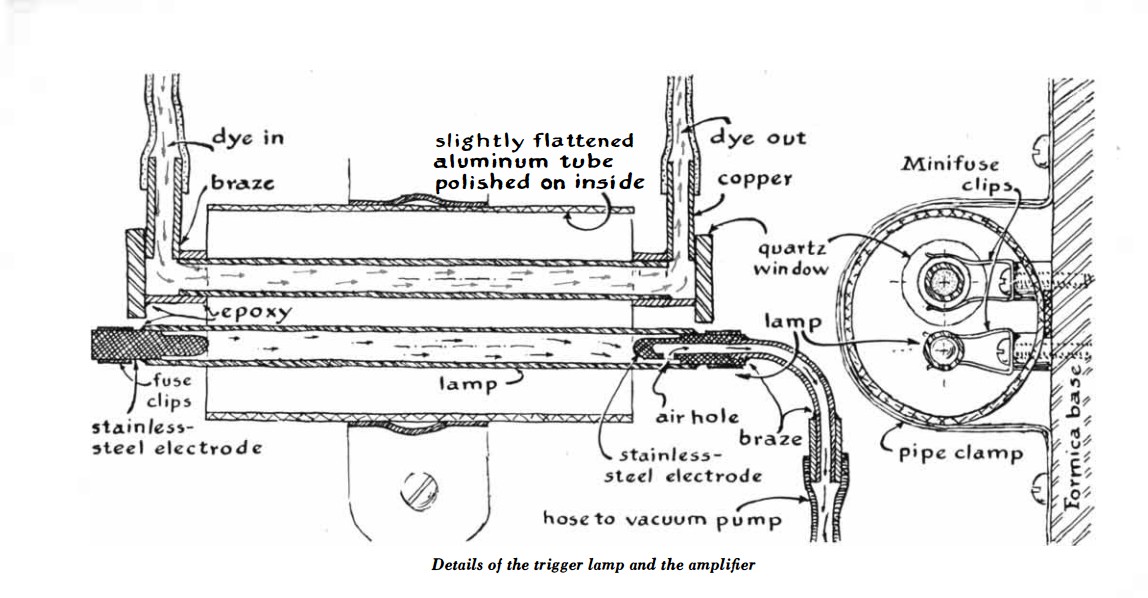
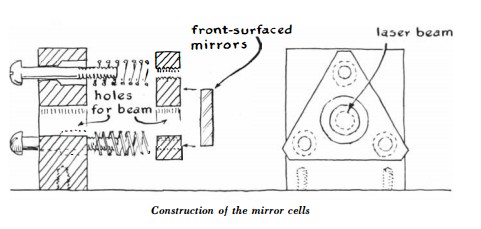
And now we will look at pictures from UT:
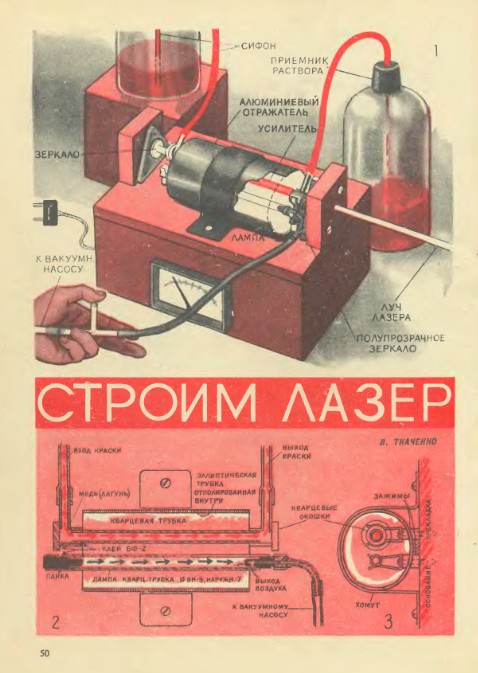
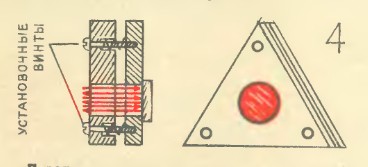
This is where the similarities in the pictures end and the differences begin. For example, let's compare the electrical diagrams given in the original and adapted articles.
Original:
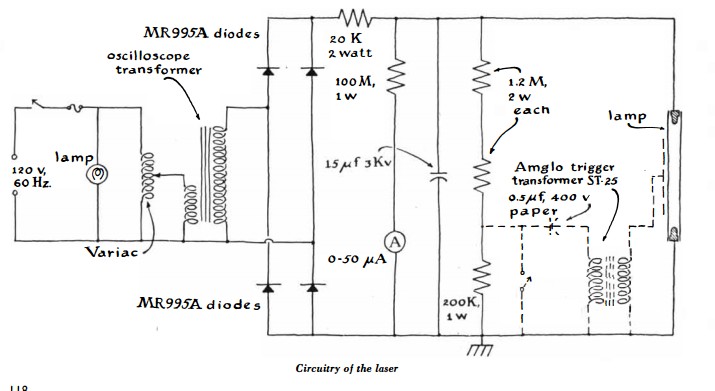
Adaptation:

As you can see, the scheme is adapted to suit our realities in terms of the element base and the network voltage. However, in the original scheme they propose to add a pre-ionization chain for the lamp, which was omitted in the adapted one. Also, as the power transformer in the original scheme, a high-voltage power transformer from an oscilloscope is proposed. And judging by the output voltage, it meant the power winding of the CRT of this oscilloscope. The person who translated the article most likely understood everything correctly, but in an impulse to adapt to our realities, he probably remembered about TVs (TV is easier to disassemble in the garbage can than an oscilloscope), where the CRT is powered by the high-voltage winding of the horizontal transformer. Therefore, he called the power transformer in the adapted circuit as “TVS”, similarly to the horizontal transformer. As is known, a typical fuel assembly is wound on a ferrite core and cannot operate at a frequency of 50 Hz. And this is a very annoying error, which reduces the probability of successful operation of the laser to zero. The fact is that for a dye laser, the duration of a flash, which lies in the microsecond range, is very critical. The proposed pre-ionization circuit in the original article allows us to accelerate the development of a discharge in a lamp and reduce the duration of a flash. And it is also advisable to do as closely as possible the installation of the structure, with the shortest possible conductors. Moreover, in the original article it is written that the storage capacitor must have a small parasitic inductance. More precisely, "should be designed for discharges of short duration." And they directly stated that ordinary capacitors will not work - the laser will not work with them. In an adapted article about such insignificant things, they decided not to mention. Let's compare the text of the original and adaptation. Red highlighted low-inductance capacitor requirement.
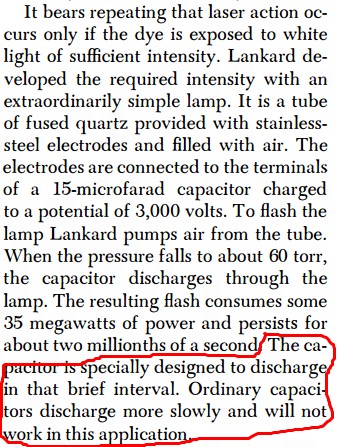
In an adapted article about a low-inductance capacitor, they were silent. And once silent, it means that you can run after the first electrolytes, the use of which will make the laser operation impossible.

This alone is enough to make an attempt to “blindly” repeat what was described in the article from “UT” that ended in complete failure, since the need for a low-inductance capacitor is completely unclear to either an unprepared “follower” or even an ordinary teacher of a technical circle. Unless of course he is not grounded in laser technology. I am already silent about TVS, it would be better to recommend at least a "power transformer from an oscilloscope."
I also note that in the original article there is a supplement on how to make a device out of a diffraction grating for tuning the laser wavelength, which was also kept silent about in the adapted article.
What to do if you still wanted to build a dye laser yourself? First you need to read specialized literature. And even better - foreign primary sources. Fortunately, there is already an alternative to the article from “YT”. The most detailed and thorough description is on the site of a fairly well-known homeowner Yun Sothory.
The material is a compilation of extracts from specialized articles and his extensive personal experience, therefore, you can safely use it.
And now I propose to look inside the already "real" mass-produced dye lasers. To begin with, let's look inside the pulsed LOS-4M laser, in some sources called “Rainbow”.

This is a lamp-pumped laser with a declared output energy of 1 J without selecting a wavelength. Adding a selective element (diffraction grating) to the optical resonator reduces the output energy, but allows you to adjust the radiation wavelength.
The possibility of selecting the radiation wavelength is the most valuable property of dye lasers and it can be carried out in different ways. You can put a diffraction grating or a prism behind the output mirror of the resonator, can be installed inside the resonator. In the second case, a narrower radiation line is reached. In addition to the lattice or prism, the principle of operation of which is evident, polarization filters are also used, as described below.
As you can see, the device of the emitter is almost identical to the classical solid-state laser, only instead of a rod made of a laser crystal or glass there is a tube through which the dye solution flows. Outside, this tube is surrounded by another, through which the filter solution flows, designed to cut off short-wave UV from pumping lamps, which quickly destroys the dye. The pumping is carried out with two IFP-1200 lamps. The resonator is formed by a deaf mirror hidden in the end of the quantron and translucent at a distance from it.
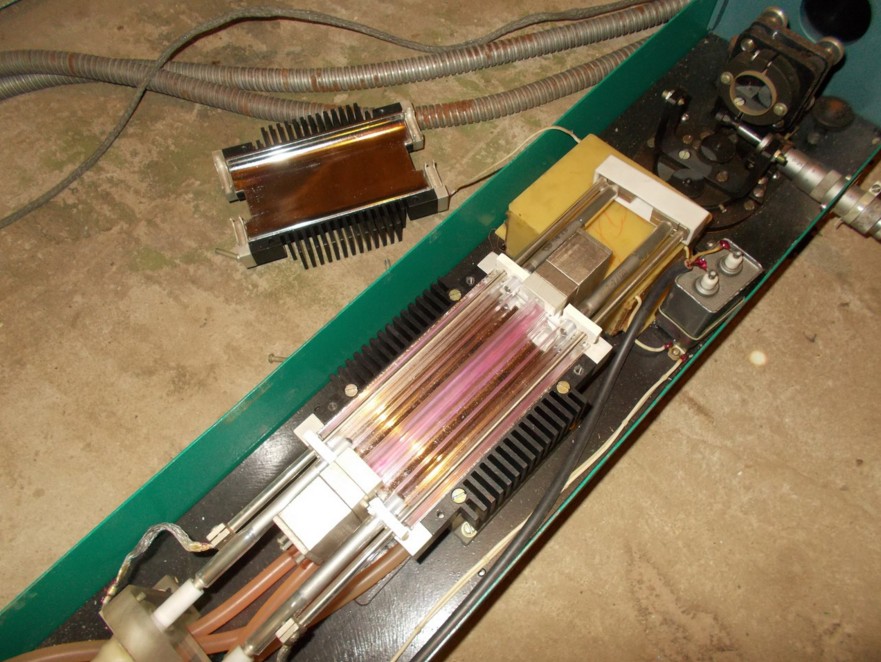
Between the quantron and the output mirror is a holder for a diffraction grating, the position of which can be adjusted with a micrometer screw. The hoses are supplied solutions of the dye and filter. The emitter is connected to the power supply unit by coaxial cables, which have low parasitic parameters.

Let's look now at the power supply.

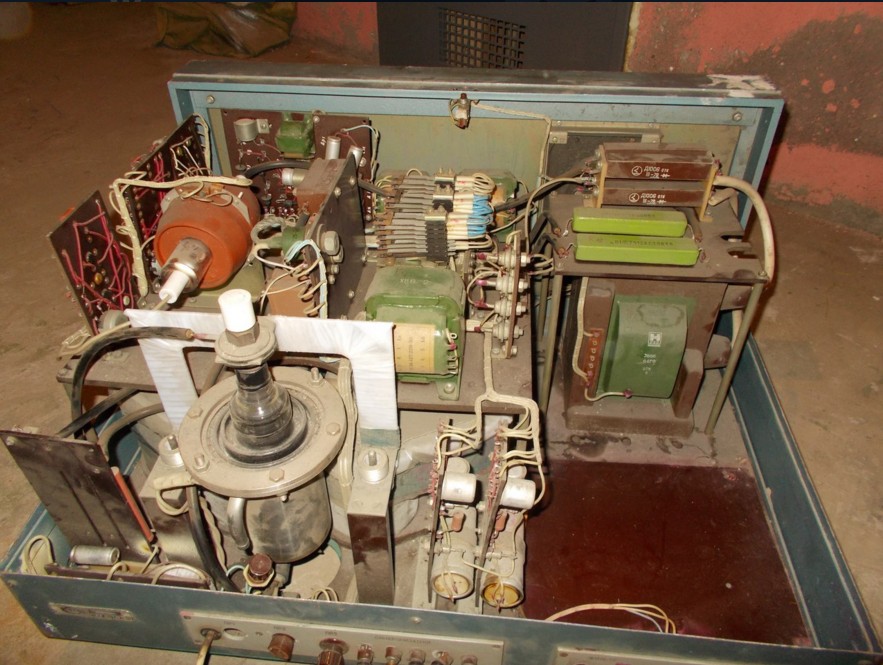
In the foreground ignitron discharger IRT-2 catches the eye. The fact is that the battery of capacitors is charged to a voltage that obviously exceeds the voltage of the self-breaking of the IFP-1200 lamps. In order for the laser to work in a controlled mode and shoot when we need it, and not when it pleases, then a control element is used in the form of this discharger. Its advantages are that it is capable of switching large energy in a single pulse, has small parasitic parameters, has a very long service life and does not require any maintenance, unlike traditional spark gaps, which require periodic adjustment of the spark gap and contact cleaning. To the right in the corner there is a high-voltage transformer with a rectifier and ballasts for charging capacitors. On the large plate to the left of the transformer is placed auxiliary electronics to control the ignitron discharger and the process of charging capacitors. Capacitors are under it.
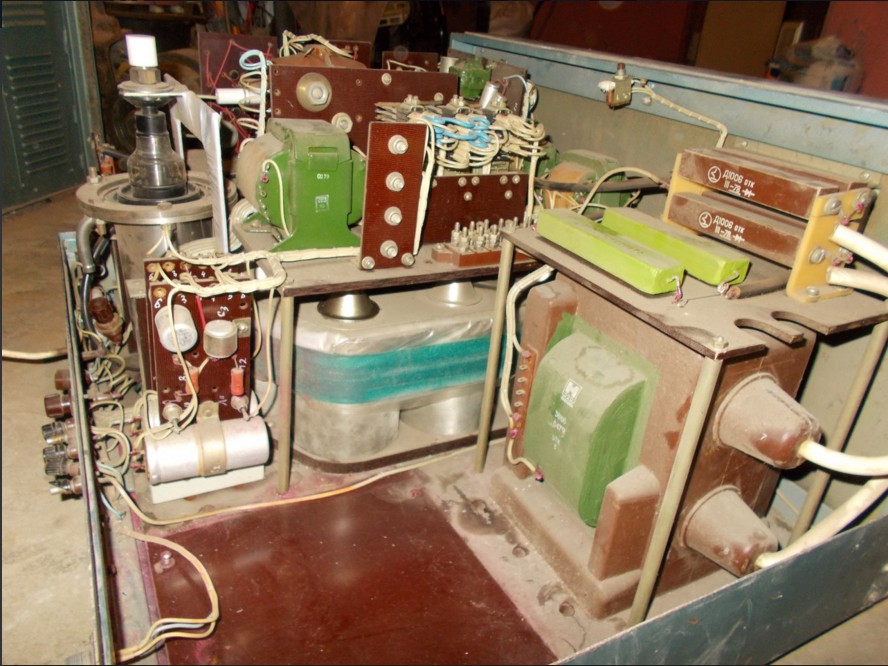
Each pump lamp has 6 capacitors, each with a capacity of 2 microfarads, a voltage of 5 kV. Capacitors of low inductance series k75-30. In total, 12 μF 5 kV is obtained for each lamp. As you can see, the capacitance used in the serial laser is quite close to that indicated in the articles for self-repetition.
Where there is a free space in the power supply unit, there were containers with a dye and a filter and pumps for their circulation. I got the power supply unit without them, so I will have to use an external circulation unit. It consists of a pump operating at a low constant voltage (27V) and a quartz tank with a spiral soldered into it. Water is passed through the coil to cool the dye, as it collapses as the temperature rises.
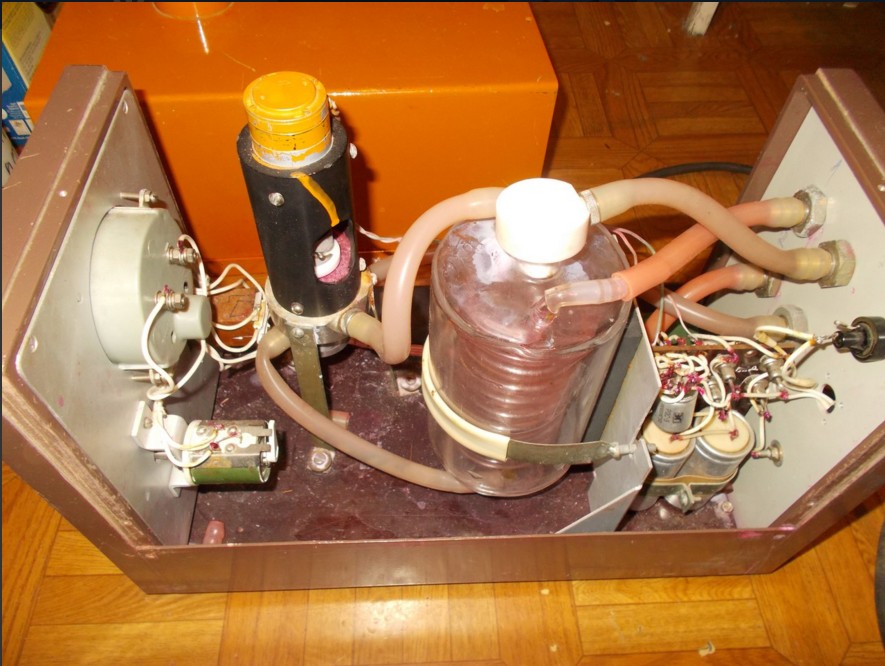

Since I am still busy with other projects, the restoration of the working condition of this laser is only in the plans so far, and the device itself has been postponed for a while. It is worth noting that there are dye lasers that use laser pumping - from another pulsed laser of the visible or ultraviolet range. Currently they are most common. In addition, there were prototypes of lasers in which, instead of a dye solution, a plastic active element colored with an appropriate organic compound was used. They use pumping by a pulsed laser, but the service life of AE is rather limited, therefore, such lasers are not widely spread.
A NR laser with a wavelength of 337 nm (UV) or excimer (wavelength and energy depends on the selected gas mixture), or pulsed neodymium with frequency doubling (532 nm) or trebling (355 nm) or quadrupling (266 nm) frequency. In some cases, the copper vapor laser I have already described is used. In these cases, the dye laser itself is a “passive” device that does not require power, except for the dye circulation pump. But if you need a large (up to tens or hundreds of joules) generation energy, then there is no alternative to tube pumping.
After reviewing the classic pulsed dye laser, one can ask what to do if radiation is inherent in a dye laser, with the inherent possibility of wavelength tuning, but with a continuous mode? And here, too, was found a way out. Consider it on the example of the laser of the American company Coherent.
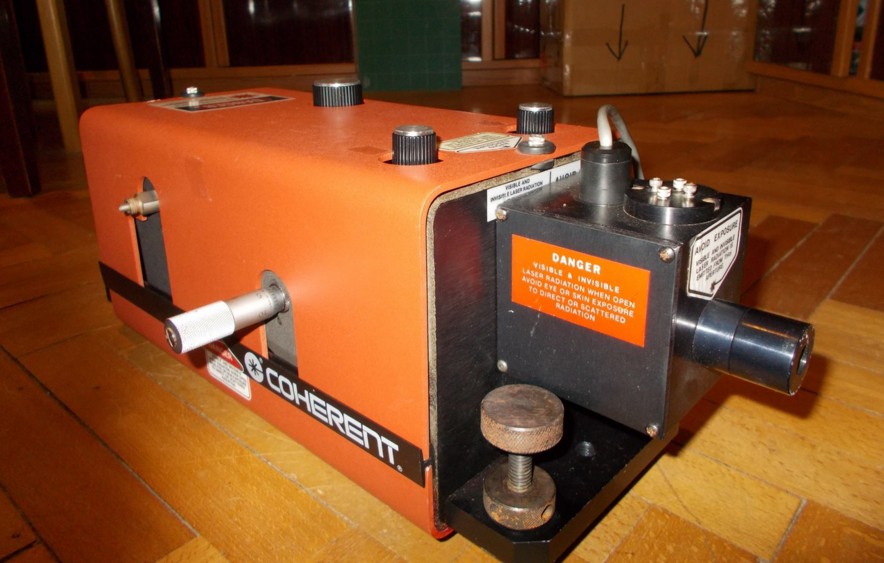
Inside this laser is a complex optical system consisting of the optics of “delivering” the pump beam and the optical resonator with a polarization wavelength selector.

If the pump laser beam is focused inside a thin and fast-flowing laminar jet of a dye solution, then it is possible to achieve lasing in a continuous mode. The pump energy density is very high, and in order for the dye to not overheat, a fast-flowing jet is needed. As a pump source, a high-power argon laser is most often used, the beam of which is focused by a selective concave mirror inside the jet. The argon laser is best suited for pumping dyes from the rhodamine group; its initial beam is very thin and easily focuses into the thinnest spot. The jet is formed by a nozzle of a flattened stainless tube.
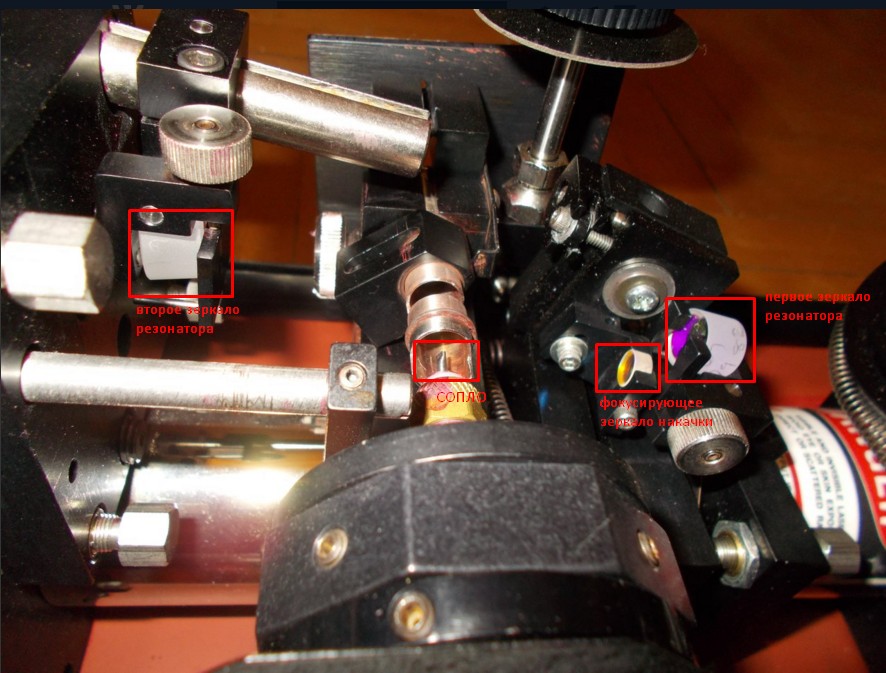
This photo did not fit the polarization selector wavelength and the third, the output mirror of the resonator.
To obtain a laminar flow, a dye solution in ethylene glycol of a given temperature and viscosity is needed, and a special pump is used for pumping. From the pump beam, the jet shines with spontaneous radiation, and the radiation that appears between the tuned resonator mirrors is amplified and transformed into a laser beam. Inside the resonator, a polarization wavelength selector is installed, consisting of a foot of quartz plates. It works like this. The laser beam in the resonator is polarized, and the filter is installed at a certain angle, passing a certain angle of polarization. In laser radiation of different wavelengths, the angle of polarization is different, therefore, unequal losses in the filter. Thus, the wavelength at which the polarization angle ideally penetrates through the filter receives the greatest gain, while the others are suppressed. The angle of the position of the filter changes - the radiation wavelength changes.
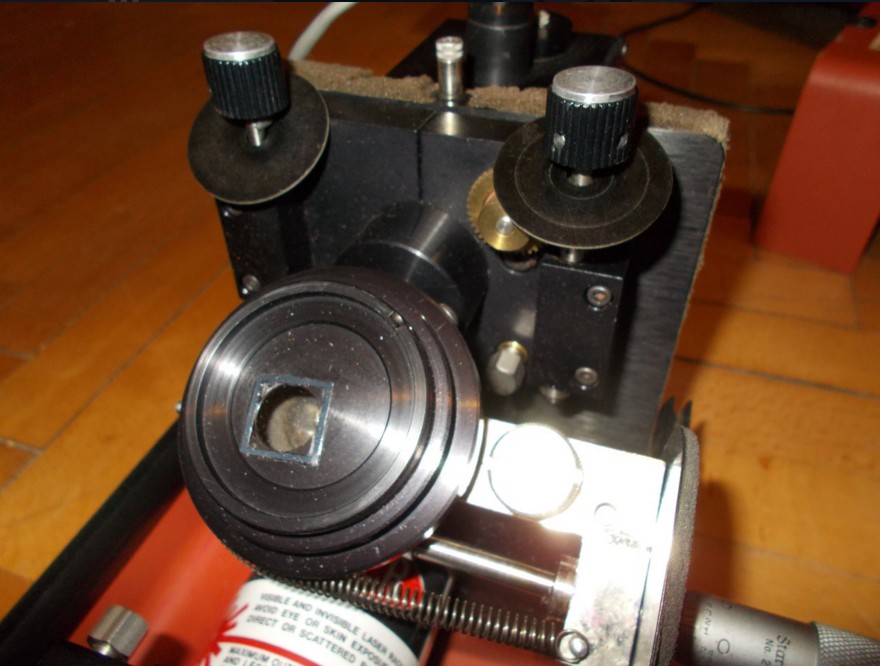
The highest efficiency is achieved when using a solution of rhodamine-6G. The output radiation power reaches 4 W at 12 W pumping. Unfortunately, I will have this laser on the shelf, since I have neither the standard solution pumping system, nor the powerful argon laser, although I have been looking for it for a long time.
Here I visualized the path of the pump beam using a small argon laser, the solution was not fed into the nozzle.

Such a small review of the most common dye lasers and the important points that need to be remembered when trying to build such a laser on your own has turned out. Do not repeat the mistakes described in the article from the children's magazine.
Despite this, neither I nor my colleagues know any precedents for the successful construction of a dye laser based on this article. Why is that? What are the hidden pitfalls in dye lasers? What is the structure of industrial dye lasers? Let's see.

Dye laser is very attractive for self-production. Since it does not need scarce and hard-to-reach crystals or glasses, or complex glassblowing work as for the manufacture of active elements of gas lasers. It consumes very little energy and produces a bright radiation of the visible range. Its radiation has a very valuable property - it can be decomposed into a spectrum and select the desired color of the beam.
')
To begin with, it should be noted that the article from “YT” No. 8 of 1971, which was later reissued in No. 11 of 1992, is not original. This is an adaptation of an article published in the column “The amateur scientist” of the American journal “Scientific American” in the February 1970 issue. And everything would be fine (maybe!) If this adaptation had not been performed with unacceptable cuts and annoying errors. First, look at the volume of both articles. The original article took 6 pages, adapted in “UT” - only 3 pages. Pictures copied almost 1 in 1. The original American article can be downloaded from here, having stolen it from the angry copywriters through sci-hub. Or already from file sharing .
Compare the similarity of pictures in the original and adapted articles.
Original:



And now we will look at pictures from UT:


This is where the similarities in the pictures end and the differences begin. For example, let's compare the electrical diagrams given in the original and adapted articles.
Original:

Adaptation:

As you can see, the scheme is adapted to suit our realities in terms of the element base and the network voltage. However, in the original scheme they propose to add a pre-ionization chain for the lamp, which was omitted in the adapted one. Also, as the power transformer in the original scheme, a high-voltage power transformer from an oscilloscope is proposed. And judging by the output voltage, it meant the power winding of the CRT of this oscilloscope. The person who translated the article most likely understood everything correctly, but in an impulse to adapt to our realities, he probably remembered about TVs (TV is easier to disassemble in the garbage can than an oscilloscope), where the CRT is powered by the high-voltage winding of the horizontal transformer. Therefore, he called the power transformer in the adapted circuit as “TVS”, similarly to the horizontal transformer. As is known, a typical fuel assembly is wound on a ferrite core and cannot operate at a frequency of 50 Hz. And this is a very annoying error, which reduces the probability of successful operation of the laser to zero. The fact is that for a dye laser, the duration of a flash, which lies in the microsecond range, is very critical. The proposed pre-ionization circuit in the original article allows us to accelerate the development of a discharge in a lamp and reduce the duration of a flash. And it is also advisable to do as closely as possible the installation of the structure, with the shortest possible conductors. Moreover, in the original article it is written that the storage capacitor must have a small parasitic inductance. More precisely, "should be designed for discharges of short duration." And they directly stated that ordinary capacitors will not work - the laser will not work with them. In an adapted article about such insignificant things, they decided not to mention. Let's compare the text of the original and adaptation. Red highlighted low-inductance capacitor requirement.

In an adapted article about a low-inductance capacitor, they were silent. And once silent, it means that you can run after the first electrolytes, the use of which will make the laser operation impossible.

This alone is enough to make an attempt to “blindly” repeat what was described in the article from “UT” that ended in complete failure, since the need for a low-inductance capacitor is completely unclear to either an unprepared “follower” or even an ordinary teacher of a technical circle. Unless of course he is not grounded in laser technology. I am already silent about TVS, it would be better to recommend at least a "power transformer from an oscilloscope."
I also note that in the original article there is a supplement on how to make a device out of a diffraction grating for tuning the laser wavelength, which was also kept silent about in the adapted article.
What to do if you still wanted to build a dye laser yourself? First you need to read specialized literature. And even better - foreign primary sources. Fortunately, there is already an alternative to the article from “YT”. The most detailed and thorough description is on the site of a fairly well-known homeowner Yun Sothory.
The material is a compilation of extracts from specialized articles and his extensive personal experience, therefore, you can safely use it.
And now I propose to look inside the already "real" mass-produced dye lasers. To begin with, let's look inside the pulsed LOS-4M laser, in some sources called “Rainbow”.

This is a lamp-pumped laser with a declared output energy of 1 J without selecting a wavelength. Adding a selective element (diffraction grating) to the optical resonator reduces the output energy, but allows you to adjust the radiation wavelength.
The possibility of selecting the radiation wavelength is the most valuable property of dye lasers and it can be carried out in different ways. You can put a diffraction grating or a prism behind the output mirror of the resonator, can be installed inside the resonator. In the second case, a narrower radiation line is reached. In addition to the lattice or prism, the principle of operation of which is evident, polarization filters are also used, as described below.
As you can see, the device of the emitter is almost identical to the classical solid-state laser, only instead of a rod made of a laser crystal or glass there is a tube through which the dye solution flows. Outside, this tube is surrounded by another, through which the filter solution flows, designed to cut off short-wave UV from pumping lamps, which quickly destroys the dye. The pumping is carried out with two IFP-1200 lamps. The resonator is formed by a deaf mirror hidden in the end of the quantron and translucent at a distance from it.

Between the quantron and the output mirror is a holder for a diffraction grating, the position of which can be adjusted with a micrometer screw. The hoses are supplied solutions of the dye and filter. The emitter is connected to the power supply unit by coaxial cables, which have low parasitic parameters.

Let's look now at the power supply.


In the foreground ignitron discharger IRT-2 catches the eye. The fact is that the battery of capacitors is charged to a voltage that obviously exceeds the voltage of the self-breaking of the IFP-1200 lamps. In order for the laser to work in a controlled mode and shoot when we need it, and not when it pleases, then a control element is used in the form of this discharger. Its advantages are that it is capable of switching large energy in a single pulse, has small parasitic parameters, has a very long service life and does not require any maintenance, unlike traditional spark gaps, which require periodic adjustment of the spark gap and contact cleaning. To the right in the corner there is a high-voltage transformer with a rectifier and ballasts for charging capacitors. On the large plate to the left of the transformer is placed auxiliary electronics to control the ignitron discharger and the process of charging capacitors. Capacitors are under it.

Each pump lamp has 6 capacitors, each with a capacity of 2 microfarads, a voltage of 5 kV. Capacitors of low inductance series k75-30. In total, 12 μF 5 kV is obtained for each lamp. As you can see, the capacitance used in the serial laser is quite close to that indicated in the articles for self-repetition.
Where there is a free space in the power supply unit, there were containers with a dye and a filter and pumps for their circulation. I got the power supply unit without them, so I will have to use an external circulation unit. It consists of a pump operating at a low constant voltage (27V) and a quartz tank with a spiral soldered into it. Water is passed through the coil to cool the dye, as it collapses as the temperature rises.


Since I am still busy with other projects, the restoration of the working condition of this laser is only in the plans so far, and the device itself has been postponed for a while. It is worth noting that there are dye lasers that use laser pumping - from another pulsed laser of the visible or ultraviolet range. Currently they are most common. In addition, there were prototypes of lasers in which, instead of a dye solution, a plastic active element colored with an appropriate organic compound was used. They use pumping by a pulsed laser, but the service life of AE is rather limited, therefore, such lasers are not widely spread.
A NR laser with a wavelength of 337 nm (UV) or excimer (wavelength and energy depends on the selected gas mixture), or pulsed neodymium with frequency doubling (532 nm) or trebling (355 nm) or quadrupling (266 nm) frequency. In some cases, the copper vapor laser I have already described is used. In these cases, the dye laser itself is a “passive” device that does not require power, except for the dye circulation pump. But if you need a large (up to tens or hundreds of joules) generation energy, then there is no alternative to tube pumping.
After reviewing the classic pulsed dye laser, one can ask what to do if radiation is inherent in a dye laser, with the inherent possibility of wavelength tuning, but with a continuous mode? And here, too, was found a way out. Consider it on the example of the laser of the American company Coherent.

Inside this laser is a complex optical system consisting of the optics of “delivering” the pump beam and the optical resonator with a polarization wavelength selector.

If the pump laser beam is focused inside a thin and fast-flowing laminar jet of a dye solution, then it is possible to achieve lasing in a continuous mode. The pump energy density is very high, and in order for the dye to not overheat, a fast-flowing jet is needed. As a pump source, a high-power argon laser is most often used, the beam of which is focused by a selective concave mirror inside the jet. The argon laser is best suited for pumping dyes from the rhodamine group; its initial beam is very thin and easily focuses into the thinnest spot. The jet is formed by a nozzle of a flattened stainless tube.

This photo did not fit the polarization selector wavelength and the third, the output mirror of the resonator.
To obtain a laminar flow, a dye solution in ethylene glycol of a given temperature and viscosity is needed, and a special pump is used for pumping. From the pump beam, the jet shines with spontaneous radiation, and the radiation that appears between the tuned resonator mirrors is amplified and transformed into a laser beam. Inside the resonator, a polarization wavelength selector is installed, consisting of a foot of quartz plates. It works like this. The laser beam in the resonator is polarized, and the filter is installed at a certain angle, passing a certain angle of polarization. In laser radiation of different wavelengths, the angle of polarization is different, therefore, unequal losses in the filter. Thus, the wavelength at which the polarization angle ideally penetrates through the filter receives the greatest gain, while the others are suppressed. The angle of the position of the filter changes - the radiation wavelength changes.

The highest efficiency is achieved when using a solution of rhodamine-6G. The output radiation power reaches 4 W at 12 W pumping. Unfortunately, I will have this laser on the shelf, since I have neither the standard solution pumping system, nor the powerful argon laser, although I have been looking for it for a long time.
Here I visualized the path of the pump beam using a small argon laser, the solution was not fed into the nozzle.

Such a small review of the most common dye lasers and the important points that need to be remembered when trying to build such a laser on your own has turned out. Do not repeat the mistakes described in the article from the children's magazine.
Source: https://habr.com/ru/post/430108/
All Articles